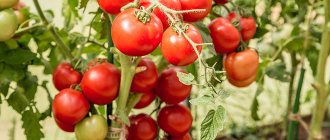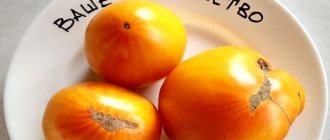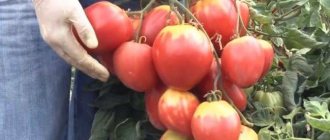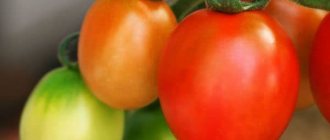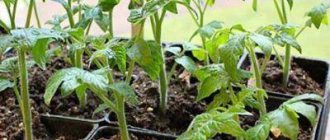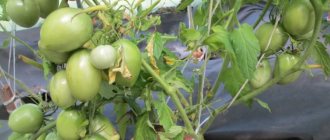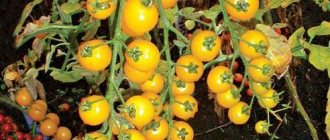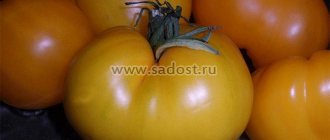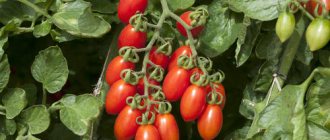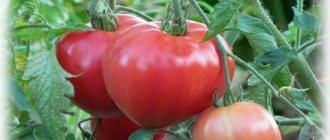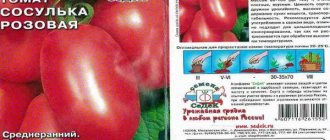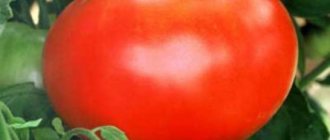Description and characteristics
Over the years of cultivation, several varieties of this variety have been developed, differing mainly only in the color of the fruit. Agricultural technology and basic properties are similar. You can evaluate the appearance of the tomato in the photo.
Bush
The determinate plant reaches 50-60 cm, slightly higher in greenhouse conditions.
The bushes have weak foliage and are compact. They form independently into one main shoot. There are few side shoots, they are poorly developed and do not require removal. Later, ovaries also form on them, but the bush will be delayed in development, the fruits will be smaller, and ripening will be later. On average, you can remove 2 kg of tomatoes from a bush per season. Important
! If you still cut off the side shoots, the formation of the bush and the formation of ovaries will occur faster. Moreover, pinching of this variety is rarely required and will not cause much trouble.
Fruit
The fruits are flat-round, different color forms have been developed today (red, pink, yellow). Tied in tassels of 5-7 pieces. The taste is pronounced tomato with a slight sourness. Weight – up to 60-140 grams. The pulp is juicy, the chambers with medium-sized seeds, the peel is quite dense. Intended for fresh consumption, processing into juices and sauces, canning (including whole fruit).
Properties
“Non-swirling” refers to early varieties; fruit ripening begins 85-95 days after germination. It ties well. The yield of the harvest occurs amicably.
It is resistant to cold, so it is suitable for growing even in cool climates under film. During the period of active fruiting, it requires gartering - the bushes fall under the weight of the crop.
Large-fruited varieties
Productivity is one of the important indicators that gardeners take into account. Despite the fact that the varieties that do not require pinching are generally inferior in the number of ovaries and the size of the fruits to their tall counterparts, breeders were able to develop a number of varieties that make it possible to obtain up to 8-9 kg of tomato per 1 m2.
- Altaechka. The variety produces a harvest after 3 months, before late blight appears. The height of the bush in garden beds does not exceed 70 cm, in greenhouse conditions - 90 cm. The fruits weigh up to 300 g, have a rich scarlet color of the peel and pulp. When planting 4 bushes per 1 m2 and following agricultural technology, the yield reaches 8 kg.
- Standard large-fruited. Refers to mid-season varieties that do not require support. Compact bushes grow just over half a meter in height. The weight of an average tomato is about 350 g. Larger specimens, weighing 500 g, ripen on the lower cluster. Ripe vegetables are used for salads and making juice. It is recommended to grow in open beds with dense planting (40 cm between bushes).
- Tamara. A variety for growing under film or in open ground. The harvest ripens in 110 days. It is valued for the high taste qualities of ripe tomatoes, weighing about 300 g. Up to 6 kg of fruits are harvested from each bush, while the height of the plant is only 80 cm. The disadvantage of the variety is susceptibility to root rot, powdery mildew and early wilting. Agricultural technology must necessarily include the prevention of these diseases.
- Tasmanian chocolate. Ripening occurs after 85 days. The bush is densely covered with dark green foliage. The flattened fruits have a red-brown skin color and a lighter flesh color. The yield is 8-9 kg per plant with a fruit weight of 250-350 g. Suitable for greenhouses, grows well in open ground in central Russia.
Large-fruited varieties need to be provided with garters so that the branches do not break under the weight of filling tomatoes.
Sowing and caring for seedlings
Like all early varieties, it is not recommended to sow more than 2 months before planting in the ground or greenhouse. Depending on the region, this is mid-March - mid-April.
The seeds are soaked in a pale solution of manganese and sown to a depth of 1 cm. Until the first sprout, they can be kept under film (to maintain moisture) in a warm place (25-27 degrees).
You can either buy ready-made soil, or prepare a mixture of garden soil, humus and peat in equal parts with the addition of river sand and ash.
With the appearance of 2 true leaves, they are planted in pots or boxes at a distance of 8-10 cm from each other. After a few days, you can feed with nitrogen-containing fertilizer.
Seedlings of the “Non-Sonny” tomato are not prone to strong stretching, but the lighting needs to be long and bright (can be illuminated with electric lamps).
Growing temperature 20-25 degrees. Before planting in the garden, the seedlings are hardened off for several days (daytime temperatures are lowered to 18, night temperatures to 13-15 degrees).
Watering is carried out immediately after the surface of the soil in the box (pot) dries out; the amount of watering depends on the air temperature. You cannot overwater the seedlings, otherwise the plants will begin to wither and fungus will appear in the ground.
Agricultural technology
Growing seedlings
To plant tomato seeds, they prefer a container filled with prepared soil consisting of a mixture of humus, peat, garden soil with the addition of ash and sand. The soil is disinfected before planting. The seeds are soaked in a weak solution of manganese and planted to a depth of about 1 cm. Until the first sprout appears, the seedlings are kept under a film, ensuring that the temperature is maintained at about 24-27 degrees and sufficient humidity.
White Muscat grape variety: photo and description, cultivation techniques
After 1 or 2 leaves appear, the seedlings are plucked, leaving a distance of 9-10 cm between the seedlings, or planted in pots. It is necessary to water the seedlings with regular precision; it is best to do this in the morning; this is an important aspect for the formation of the future bush. To avoid contamination of future bushes with bacteria, the room with seedlings must be ventilated, while preventing a decrease in the temperature in the room.
Seedlings with tomatoes
The future bush can be illuminated artificially, for example, with a phytolamp. To organize natural lighting, seedlings can be placed near a window, placing it at an angle and using reflective foil. However, you shouldn’t overdo it either; 12 hours of lighting is enough for plants, the remaining hours need to be spent in the dark. This process of alternating night and day is needed for a kind of hardening of seedlings and getting used to the natural physiology of plants.
After five or six leaves appear, the lower leaves need to be removed; gardeners recommend this manipulation to avoid pulling the plants upward.
Before planting non-sapling tomatoes in open ground, it is necessary to harden the seedlings; to do this, you can gradually take the boxes out into the fresh air. You need to start with a half-hour stay in the air, gradually increasing the time. Hardening can be carried out before the daytime air temperature reaches 14-15°C.
Planting seedlings in open ground
It is necessary to plant seedlings in open ground in cloudy weather or in the evening. This is done so that the plant takes root a little overnight before being exposed to the scorching rays of the sun during the day. The holes for tomato seedlings should be the size of a spade bayonet; before planting, they should be filled with water and wait until it is completely absorbed into the soil. Before planting, seedlings must be watered abundantly so that tomatoes can be easily removed from the pots without damaging the root system.
Planting seedlings in open ground
After immersing the tomatoes in the hole, the roots are carefully sprinkled with soil mixed with compost, then the hole is filled with earth, carefully compacted. After planting, the plants must be watered abundantly.
In the first days, until the seedlings take root, in order to avoid night frosts and drafts, the seedlings must be covered with a transparent film. Experienced gardeners recommend removing the film after 10-12 days. This time is enough for rooting. During this period, it is better to minimize watering or not to water at all; the first moistening of the seedlings can be done after the film is no longer needed.
Watering tomatoes
Initially, after planting, young seedlings are watered with warm, room temperature, settled water. When carrying out the procedure, you must try to water the bushes at the root or between the rows, without getting on the leaves of the plants. Watering should provide moisture to the main roots. They are located at a depth of about 35-40 cm.
Watering should be regular, it is necessary to adhere to a certain scheme and moisten the plants at least once every four to five days. If you water tomatoes at different intervals: sometimes less often, sometimes more often, future fruits will crack, and storing such tomatoes will be much more difficult.
Diseases of tomato Nepas
The unpretentiousness and resistance of Nepas to diseases does not mean that the tomato does not require minimal care. By periodically monitoring the plant and promptly eliminating problems, you can avoid many diseases.
Sudden yellowness on the leaves and their lightening indicate a lack of mineral fertilizer.
Leaves that have taken on a sickly purple hue will indicate a deficiency of nitrogen or phosphorus in the soil. Drying of the leaves indicates a lack of potassium.
If drying of the ovaries is observed, this may be due to excess phosphorus. The lack of flowering and growth of leaves indicates an excess of nitrogen. Excess potassium will appear as dull spots on the leaves.
Tomato diseases
A bacterial infection will manifest itself as multi-colored spots on the leaves. For any signs of infection, the use of drugs such as “Skor”, “Fitosporin”, “Zaslon” will be effective.
Features of cultivation
The variety “Non-Sonny” does not require special attention, but you need to learn the simple rules of agricultural technology.
You may be interested in: Dates for planting tomato seedlings in open ground and greenhouses according to the garden calendar Favorable days for planting tomatoes for seedlings in 2021 according to the lunar sowing calendar Favorable days for picking tomatoes in 2021 after germination: timing of picking tomato seedlings in the table by day
Bedding
The plant does not tolerate negative temperatures, but is resistant to cool temperatures, so it can be planted in a greenhouse or under film quite early. 4 plants can be freely accommodated per square meter. Each hole can be fertilized with a handful of ash, humus and a small amount of nitrogen fertilizer.
Watering
During the growing season, abundant watering is required. It is better to do this not too often (about 2 times a week or a little less often, depending on the temperature), but a lot.
Important
! The amount of watering must be adjusted according to the weather and the condition of the plants. Too thick trunks and thick, juicy, spreading foliage indicate an excess of moisture. If you do not limit watering in time during this period, the bush will turn out to be powerful and large, but the yield will be greatly reduced.
When the fruits have set, grow and ripen, watering is reduced to avoid cracking and wateriness of the tomato.
Fertilizers
Before abundant flowering begins, fertilizers with a high nitrogen content are added to the soil - this helps the plant quickly gain green mass. When fruiting begins, tomatoes need potassium and phosphorus. A total of 3 feedings per season are sufficient.
Diseases
The variety is resistant to diseases. Following the content rules will help you avoid them. Like all tomatoes, “Never-Sonny” does not like high air humidity and stuffiness, or excessive soil moisture.
Pests
It is weakly affected by parasites. Like other varieties, it can be attacked by aphids, whiteflies, and spider mites. Timely processing and compliance with growing rules will help. Spraying with a soap solution, ash diluted in water, or special preparations is effective against pests.
How to grow varieties of the Nepas series
Some “totally lazy” gardeners grow Nepas series tomatoes using the seedless method, that is, they sow their seeds directly into the ground. Since tomatoes are a heat-loving crop, they are sown with seeds in warm beds, box beds or buckets.
Fragrant geranium: medicinal properties and contraindications, plant care at home
We grow non-sprouting tomatoes in buckets
This method has been used since the late 40s of the last century. Back then they used buckets without a bottom. The harvest obtained by this method is no worse, and sometimes even better, than using the conventional method.
What are the advantages of this method? The soil warms up well in a bucket; under unfavorable conditions, it can be brought into a greenhouse or even into a house, no need to weed. The sun illuminates the plants well. They can be used for garden decoration.
In metal containers and black containers, the soil warms up especially well, which accelerates the growth of tomatoes. Water and fertilizers are not wasted, the plant receives them completely.
The soil for growing tomatoes in buckets is prepared from turf soil (medium loam), humus in equal parts, 300 g of wood ash is added to 1 bucket, peat or sawdust is added. The soil is steamed over an open fire and watered with a solution of rich pink potassium permanganate, diluted at the rate of 1 g per 10 liters of water.
If there are any, holes are made in the bottoms of the buckets so that the water does not stagnate. However, it should be taken into account that if the holes are too large, the water will quickly “leave”, so some gardeners do not make holes, but simply put drainage (broken brick, expanded clay, etc.) on the bottom, covering the top with non-woven material.
What are the advantages of planting tomatoes in buckets, what are the nuances of caring for them in this method - watch the video about this.
How to grow tomatoes in buckets (Alenin's garden):
In box beds
Growing low-growing tomatoes in box beds is popular. What is a box bed? This is a high bed, fenced with wooden frames made of boards or rods. Experts consider the most convenient size for such beds to be 6 m long and 1.2 m wide, but this depends on your capabilities.
Arches are installed over the ridges, on which covering material (film, non-woven material) is laid to extend the season, speed up the ripening of the crop, and protect the plants from the vicissitudes of the weather.
A box bed is formed from plant residues and food waste, which provide heat during rotting, so tomatoes can be grown in them directly from seeds.
Advantages and disadvantages
The “Nepasynkuyushchiy” tomato has many advantages over other varieties:
- obtaining an early and friendly harvest;
- endurance;
- saving time on stepsoning;
- cold resistance;
- resistance to major diseases and pests of nightshades;
- the ability to grow in any region (both hot and cool climates);
- due to its compact size, it is easy to cover in case of frost, and also to compact the planting to 5-6 pieces per square meter.
There are few disadvantages, but they are very significant: the taste of this tomato is inferior to many modern varieties, and the yield per bush is not so high (since the bushes are low, and the fruits often grow small and ripen quickly).
Advantages of non-grafting varieties
In order for the maximum number of tomatoes of excellent taste to form and ripen on the bush during the season, the correct ratio of shoots and fruits is required. Excess foliage takes away from the plant the nutrients necessary for the full development of the tomato. In order to direct the strength of tomato bushes to ripening the crop, gardeners remove some of the shoots. First of all, this concerns stepsons - shoots growing in the axils of the main trunk.
This measure promotes the formation of the number of ovaries that can ripen before the onset of cold weather. In addition, removing side shoots allows you to maintain uniform illumination of the foliage throughout the season. Tomato varieties that do not require pinching are, to some extent, tomatoes for the lazy. Taking care of them requires less time and effort. The bushes stop growing on their own after setting several fruit clusters; the growth of their lateral shoots is limited.
Most varieties are early, low-growing tomatoes intended for open beds. Among the non-sapling varieties there are hybrids that are resistant to common diseases of the nightshade family. Based on reviews from gardeners, well-proven varieties can be identified.
Reviews
The “Never-Growing” tomato is in fairly high demand among gardeners, and the reviews are often positive, since it is easier to harvest from it than from many other varieties, even in a lean year.
“For two seasons in a row, I planted the Invincible Tomato in open ground. The first year was incredibly pleasing - the summer was hot, there was little rain. The tomatoes grew in abundance and taste wonderful. And that year it was cold and damp all summer, the harvest was noticeably smaller, and some of the tomatoes turned black and rotted. The conclusion is that any, even unpretentious, varieties are best grown under cover in bad weather.”
“I’ve been growing the Nepasynkuyuschiy variety for several years now. In the greenhouse it produces consistently high yields. The bushes are small and all covered with tomatoes! True, without a garter they fall quickly. Until the fall, new clusters are formed, although, of course, the bulk of the harvest occurs in the summer, almost simultaneously.”
Varieties
Below we present to your attention non-sapling varieties of tomatoes for the greenhouse.
Red non-grafting tomato
The bush of such a tomato has few leaves, small, only 50 cm, but the fruits grow up to 60-70 grams each. Such a plant can grow in the most unpretentious conditions. It is planted both in greenhouses and in open-air beds. The fruits of this variety ripen very quickly and taste amazingly delicious. These tomatoes should be eaten raw, in salads and natural juices.
Moreover, the fruits contain a high content of lycopene, a huge amount of vitamins and various beneficial microelements.
Tomato Nepasynkuschiy pink
Unlike other non-sapling tomatoes, this variety is distinguished by large fruits, which is generally not typical for early-ripening varieties. The fruit reaches 150 grams each and has juicy, tasty pulp. The color of the fruit is bright crimson, and the bush itself is no more than 60 cm. At the same time, there is no need to remove stepsons when caring for plants and you can grow tomatoes even in open ground, they are so unpretentious.
The variety is valued for its early, vigorous ripening, high yield, resistance to diseases and fruit cracking. Tomatoes of this variety are good for pickling because they have thick skin. But the fruits are also suitable for salads, lecho and some sauces.
Tomato Pickling non-sapling
This tomato variety is distinguished by oblong-shaped fruits and they are denser compared to other varieties of tomatoes, and the bush itself reaches a height of 50 cm. The Nepasynkuyu pickling variety is just suitable for pickling fruits, and with whole fruits. The fruit itself has a rich red color and reaches a size of 80 grams.
The bush of such a plant is literally completely covered with fruits, which can be stored for a long time and will not spoil. So the variety tolerates transportation well over long distances.
Tomato Nepasynkuyuschiy orange with a spout
Determinate tomatoes are not planted at all. The plant is so unpretentious that it can be grown in particularly difficult climate conditions by covering it with film. The height of a tomato bush is usually no more than 60 cm. The variety is distinguished by an excellent harvest, which begins to ripen within 100 days after the plant emerges. The fruit itself is about 70 grams in size and has a tiny orange nose. Tomatoes of this variety are delicious in taste and contain a lot of beta-kerotene.
Eating orange fruits helps strengthen the immune system, prevent cancer, and reduce the risk of atherosclerosis and other cardiovascular diseases. The variety is especially resistant to late blight, as well as various types of rot.
Tomato Nepasynkuyu cherry-shaped
The most unusual tomato variety, suitable for home and balcony gardening. This is a non-grasping species with a bush up to 40 cm with pinkish fruits similar to cherry fruits. The plant has few leaves, but is strong enough to hold a rich harvest. After all, during a season such a plant produces up to 400 fruits, 20 grams each. Gardeners with good tomato growing skills sometimes reap an even larger harvest.
Among others, the following snowy tomato varieties are popular among avid gardeners: snowy tomato, raspberry tomato and giant tomato.
Hybrids
Productive and resistant hybrid tomatoes attract gardeners who grow vegetables in regions with unfavorable climatic conditions. Among the varieties that do not require removal of stepsons, it is worth paying attention to the following tomatoes:
- Benito F1. The result of the work of Dutch breeders, which made it possible to obtain a tomato with high immunity to the most common diseases. The bushes are low-growing with drooping clusters of 7-9 fruits. A large number of ovaries forces gardeners to create additional support and tie up branches. Ripe tomatoes are cream shaped, scarlet in color and have a thick skin. The weight of vegetables varies between 40-70 g.
- Biathlon F1. Determinate hybrid for open beds and growing under film. The fruits are collected in clusters of 6-7 pieces. The bush independently stops growth at the level of 80-90 cm. Smooth, round red tomatoes are more suitable for canning. The weight of one fruit does not exceed 100 g. The hybrid is resistant to the mosaic virus.
- Irishka F1. Very productive tomato with long fruiting. Determinate bushes are grown without pinching, although some gardeners remove side shoots growing below the first cluster. Ripening begins after 80-90 days and continues until the end of the season. Ripe tomatoes have a sweet taste and weigh 40-70 g.
Hybrids are somewhat inferior in taste to varietal vegetables. In addition, it makes no sense to collect their seeds for sowing for the next season.
